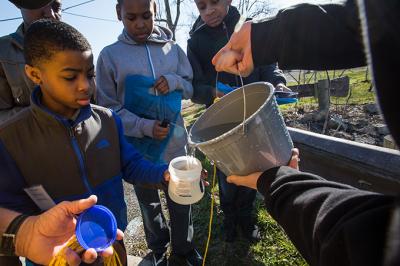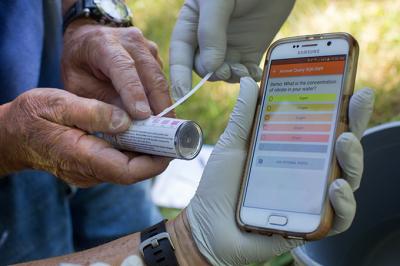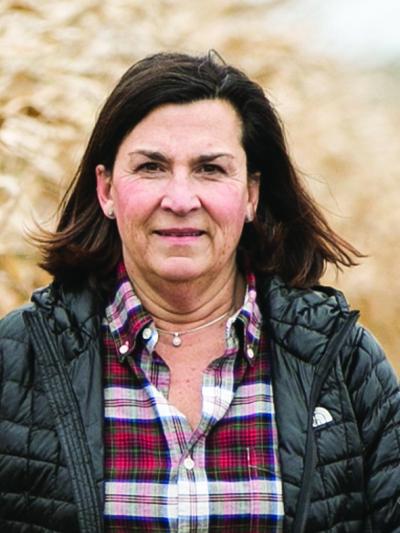Blooms of poisonous blue-green algae threaten the western basin of Lake Erie, the source of drinking water for millions of people. Rotarians are joining the fight.
For 56 hours in August 2014, nearly a half-million people living along the shores of the largest freshwater lake system in the world could not drink the water out of their taps. They couldn’t use it to brush their teeth or wash their dishes. Restaurants shut their doors. Hospitals canceled elective surgeries. Stores ran out of bottled water, and the Ohio National Guard stepped in to help.
Not all algae is dangerous. Green algae, above, is the foundation of the aquatic food chain in Lake Erie. But blue-green algae, which Rotarians are fighting, produce highly potent toxins.
A bloom of cyanobacteria, or blue-green algae, had poisoned the western basin of Lake Erie, the source of drinking water for Toledo, Ohio. The algae had been fed by nitrogen and phosphorus runoff that heavy rains had washed down the Maumee River, the largest watershed in the Great Lakes. Lake Erie is the shallowest of the Great Lakes and therefore the warmest, creating ideal conditions for the toxic algae to flourish. Wind and waves carried the bloom to the intake pipe for the city’s water supply. Drinking the contaminated water can cause symptoms ranging from fever, vomiting, and headaches to liver failure and death.
Over the previous five summers, major algae blooms had become more common, and water managers in Toledo and nearby communities were bracing for the possibility of a bloom contaminating the water supply.
How did we get to this point? Who or what is to blame? The pioneers who settled the area? Paved-over cities? Old, leaky septic tanks on rural properties? The mania for lush lawns? Changing farming practices?
The answer is all of them – all of us. That means we all must play a role in solving the problem. It’s a complex knot, but one that Rotary may be uniquely poised to untangle.

Illustration by Alexander Vidal
It all started with a big swamp. The Great Black Swamp, to be exact. That’s what the area southwest of Lake Erie was called, a thickly wooded and deeply mucky wetland almost as big as Connecticut and as old as the glaciers. The mud preserved the skeletons of mastodons that once roamed the area and, later, trapped the wagons of pioneers on their way west, forcing them to make a long detour.
Beginning in the 1850s, settlers drained most of the swamp to take advantage of the fertile soil, some of the most productive farmland in the country. They laid 15,000 miles of underground drain tiles that still whisk rainwater from farm fields into ditches that then feed into creeks and rivers and eventually the Maumee – an aquatic superhighway to Lake Erie. But in doing so, they removed the lake’s “kidneys” – the wetlands that had filtered the water before it reached the Maumee River. (Today, one of the last bits of the swamp remains at Pearson Metropark just outside Toledo, accessible to visitors via crushed gravel paths and Depression-era bridges.)
Toledo, nicknamed Frog Town, grew into a city, and by the 1960s, industrial pollution and phosphorus used in fertilizers and detergents had reduced Lake Erie to a stinking, contaminated mess. Blue-green algae blooms fed by runoff and by unregulated dumping of sewage by shoreline towns and cities sucked the oxygen out of the water. In nearby Cleveland, oil slicks caused the Cuyahoga River to catch fire more than once, most famously in 1969. The crisis spurred the passage of the U.S. Clean Water Act in 1972, which regulated industrial dumping and provided funding to upgrade wastewater treatment plants. States banned some phosphate detergents, which had been a big contributor to the algae growth.
Algae blooms around the world
Harmful algae blooms can be found anywhere there is nutrient runoff into the shallow, warm water where cyanobacteria thrive.
- In Brazil, 116 kidney dialysis patients suffered from liver failure, resulting in 52 deaths, after they received dialysis water from a reservoir contaminated with microcystins, a poison produced by cyanobacteria.
- In Australia, 148 adults and children were poisoned when they drank water taken from a lake with high levels of cyanobacteria.
- Microcystin toxin levels above the World Health Organization’s safe drinking water level have been found in cyanobacteria blooms in Bangladesh, Brazil, Ghana, Mexico, Nigeria, the Philippines, Singapore, Sri Lanka, Thailand, Uganda, Vietnam, and Zimbabwe.
- One toxic algae bloom may have resulted in a massive fish kill in a subsistence community in Bangladesh, though no analysis was performed on those samples.
Source: Journal of Limnology, 2015
In the wake of the new rules, Lake Erie rebounded. It is again a top fishing destination, known as the “Walleye Capital of the World.” It’s also an important stopover point for migrating birds; in the spring, the Toledo area hosts the annual “Biggest Week in American Birding,” which in 2016 drew visitors from 47 states and 22 countries.
But the green slime has returned. The culprits this time include changes in the soil that affect its ability to absorb water and changes in farming practices such as fertilizing in the fall instead of the spring and not plowing the soil – a conservation measure that has reduced soil erosion, but which researchers now believe can lead to a buildup of phosphorus on the surface of farm fields. More intense rains that have resulted from the changing climate wash more of the nutrients off the fields and into waterways. And invasive species in the lake further concentrate phosphorus and cyanobacteria. Once again, the lake is in peril.
Within weeks of the onset of the 2014 crisis, the Rotary Club of Toledo put together a two-part presentation at its regular meetings.
The first panel featured representatives from the city and the Ohio Farm Bureau, along with a professor of biology from nearby Bowling Green State University. After the discussion, a Rotarian stood up and asked who was in charge of solving the problem.
“Those three fellows, who had been very animated for 45 minutes, turned into a portrait,” recalls Andy Stuart, who at the time was the club’s president-elect. The Rotarians were stunned. “We realized nobody has their arms wrapped around this – nobody is responsible.”
The next week, the speaker was U.S. Rep. Marcy Kaptur, whose district includes Toledo. “She said that Rotary needs to get involved, because Rotary solves problems,” Stuart says. “It was another jolt to us.”
Stuart, who has spent his career in radio, knows how to stir things up. Driving home after hearing Kaptur speak, he thought about Rotary’s neutral, unbiased position in the community. “If she’s serious about this, what do we do?” he thought. “I said to myself, we should sponsor a conference. No corporate dollars, no agriculture dollars, no industry dollars. It all comes from Rotary.
We’re not scientists, but what we do really well is collaborate. And we attack problems that other people can’t or won’t. We bring a nonpolitical, nonpartisan environment, where the only agenda is to do the right thing.
Andy Stuart
Rotary Club of Toledo, Ohio, USA
“We’re not scientists,” he continues. “But what we do really well is collaborate. And we attack problems that other people can’t or won’t. We bring a nonpolitical, nonpartisan environment, where the only agenda is to do the right thing.”
A year later, in October 2015, the Rotary Club of Toledo’s inaugural Lake Erie Watershed Crisis Conference was sold out. More than 300 people attended: Rotarians from Ohio, Michigan, and Ontario; politicians and policymakers including Kaptur; the EPA’s Great Lakes “water czar,” Cameron Davis; and Karl Gebhardt, who is Ohio Gov. John Kasich’s Lake Erie policy chief. The conference also drew participants from environmental groups, the Ohio Farm Bureau, and tourism organizations, as well as students and professors from local universities.
“We’re not just preaching to the choir,” Amy Brennan, Lake Erie conservation director for the Nature Conservancy, Ohio, said at the conference. “Groups like Rotary can bring an increased level of awareness to the issue.”
The conference agenda, which Stuart described as “information by fire hose,” covered the history of the algae blooms, their economic impact, and ideas for preventing future blooms and solving the problems that arise when they do occur. RI Director Jennifer E. Jones, who grew up on the Canadian side of the lake, talked about how Rotary, as a nonpartisan organization, can be effective in getting accurate information out to the public. And in a video address, RI General Secretary John Hewko, who spent his formative years on Catawba Island in Lake Erie, called water stewardship “a moral obligation.”
The Toledo club responded to the crisis by capitalizing on its connections to address the issue and create a sense of urgency; meanwhile, other Rotary clubs in districts around the lake were embarking on their own grassroots efforts to tackle the problem from other angles.
Rotarian Jim Page spearheaded the effort to clean up a bloom of cyanobacteria that had poisoned the western basin of Lake Erie in 2014.
Jim Page is a Rotarian who likes to get his hands dirty – or wet, anyhow. On this June day, he’s standing on a bridge over a stream that flows into the Maumee River. The occasional passing car interrupts the chirping of birds as he tosses a bucket over the side of the bridge, then dips test strips into the water he collects. The strips change color based on the water’s pH levels and concentrations of ammonia, phosphorus, and nitrates. He enters the results into an app on his phone.
Page, a member of the Rotary Club of Waterville, Ohio, is also involved in the International Yachting Fellowship of Rotarians’ (IYFR) Western Lake Erie fleet. In August 2014 he was at a meeting of the Rotary Club of Perrysburg when the president of Lake Erie Waterkeeper, part of a nonprofit focused on clean water called the Waterkeeper Alliance, spoke about the toxic algae bloom that was making its way down the Maumee toward the lake. “The very next morning we got the notice that we could not drink the water,” Page recalls. “Within a week IYFR had gone back to Waterkeeper, asking what we could do.”
Page grew up across the street from the Maumee. “We ice-skated on it, we had canoes, kayaks, rowboats. We fished in it, we swam in it,” he says. “When I got an opportunity to buy an outboard, I went out to Lake Erie and I’ve been on Lake Erie ever since.”



Rotary members and students from the King Academy in Toledo test the quality of water leading into Lake Erie and log the results in the KnoWare app. Exchange students from 18 other countries helped test the water on Global Youth Service Day.
Working with Waterkeeper, he and his club began testing the river water to determine where the nutrients that feed the algae were coming from.
They test in early spring to establish a baseline, and again after rains in late spring and early summer. If they see a spike in concentrations, they go upriver and test again, and they keep testing until they can narrow down the source. They then alert the local U.S. Department of Agriculture office, which works with landowners to implement conservation practices.
“Rotary’s function in this is not to go after sewage treatment plants, home septic tank systems that are leaking, or farmers, but to gather the data,” he says.
Page and his club started with seven sites along 14 miles of river in 2015. By the summer of 2016, the project had been taken on by 15 clubs testing 330 sites. Page started working with professors at Bowling Green, who were developing an app that allows anyone to use a smartphone to conduct water quality tests and share the data.

Deb Cheney, 2017-18 governor of Rotary District 6600 in Ohio, USA
With him on the bridge this June day is Deb Cheney, 2017-18 governor of Rotary District 6600 in Ohio, USA. Cheney exemplifies the perspective that Rotarians bring to local issues: She grew up on a farm about a 40-minute drive away, where her father raised soybeans, wheat, and corn. “He was still trying to buy seeds when he was in hospice,” she recalls. “Farmers never think they are going to die.” She inherited part of the land, which is still being farmed.
When she started working on the water issue, she was concerned about how it might affect farmers, whose use of fertilizer has been blamed in part for the algae blooms. “That’s part of the reason I wanted to become involved,” she says. Because of her background, she has found she can build bridges, getting people who might otherwise clam up to talk about the issue. In any case, she says, everyone she has met is more interested in finding solutions than placing blame.
“We all have to work together,” she says. “That’s what Rotary does – we bring everyone together for a common cause, and we try to find a solution that works for everybody.”
Blake Vince is a fifth-generation farmer, but he has never used a plow: His family has practiced no-till farming since 1983, and today his goal is to keep something growing on his land 365 days a year.
When he’s not raising his cash crops of winter wheat, corn, and soybeans, he has a cover crop of 18 species in the ground – a potpourri including clovers and fava beans (to return nitrogen to the soil), flax and sunflowers (for pollinators), and daikon radishes to help break up the heavy soil. After a rainstorm on a winter day, water is ponding on his neighbors’ fields, but on his, the soil soaks up excess water like a sponge.
With the cover crops on his field he can reduce erosion and use less fertilizer, and there is always a crop in the ground that can use any excess phosphorus that his cash crops didn’t use.
“As a farmer, I’d rather be part of the solution than part of the problem,” says Blake Vince, of the Rotary Club of Chatham Sunrise, Ontario, Canada.
Vince, a member of the Rotary Club of Chatham Sunrise, Ontario, Canada, lives 10 miles from Lake Erie, and any water that does drain off his fields eventually ends up there. (In 2016, he installed devices to measure the concentrations of nutrients in his runoff and compare the numbers with those from a neighboring field without cover crops.)
“As a farmer, I’d rather be part of the solution than part of the problem,” says Vince, who received a scholarship in 2013 to travel the world to research the importance of biodiversity to soil health. “Farmers are not the devil. If other people aren’t willing to change their practices – if governments aren’t going to invest in infrastructure changes – we can make all the changes we want at the farm level, and it’s all for naught.”
Vince and other members of his club created a series of short educational videos about best practices from farm to home to industry (online at cleanwaterforliving.com). The 34-member club spent $20,000 on the project and is working to get other clubs involved; it screened one of the videos at the Toledo club’s 2015 conference. “With Rotarians’ position within society, we’re hopeful that we can fly the flag of urgency up a little higher,” Vince says.
The videos exemplify what may be Rotarians’ most crucial role: advocacy. The Lake Erie watershed is shared by two countries and five U.S. states, and implementing solutions that protect the lake and the livelihoods of the people who depend on it will require legal maneuvering as well as political will. Rotarians are already using their voices as concerned citizens to bring this issue to the fore.
In February 2016, the United States and Canada agreed to adopt a target reduction in phosphorus entering Lake Erie of 40 percent by 2025. In November, Michigan declared its portion of Lake Erie impaired; under the Clean Water Act, that gives the state the ability to set and enforce limits on phosphorus. Kasich’s administration has resisted calls for Ohio to do the same, telling the Toledo Blade that it would hurt state efforts to attract business and that much progress has already been made without the designation.
Dry weather in 2016 meant the summer algae bloom was smaller than in previous years, but the problem is big and complex, and the work to clean up the lake is not done. The Toledo club hosted a second conference in 2016 that again drew 300 people and focused on solutions. Page was one of the presenters. District 6600 supported the 2015 and 2016 conferences with $10,000 district grants.
“The largest problem is that there is no leadership around this issue,” the Toledo club’s Stuart says. “What are the two things that Rotarians do best? We lead and collaborate, and this problem is going to require both of those skill sets.
“When Rotarians walk into a Rotary meeting, we set aside our personal differences and unite under the ideal of Service Above Self. It’s going to take that to solve this problem of toxic algae in our lake.”
• Read more stories from The Rotarian
The Maumee watershed is the largest of any of the rivers feeding the Great Lakes, and supplies five percent of Lake Erie’s water, considered Ohio’s breadbasket.





